Biosystems ( IF 2.0 ) Pub Date : 2020-07-20 , DOI: 10.1016/j.biosystems.2020.104208 Dan C Baciu 1

|
“What is life?” and Erwin Schrödinger's answer, “negative entropy”, inspired researchers in the 20th century to unite physics, chemistry, and physiology into a new synthesis that many believe to be an important foundation for life science today. Decades after Schrödinger, life scientists are still fascinated by the riddle that entropy can only accumulate in physical systems, which often leads to biological deterioration and death, but life finds ways to persist and prevail. So to say, life “negates” entropy. Can this fascination and research concept be broadened even further to human culture? Short after Schrödinger's publication, Claude Shannon coined the term “information entropy.” Information entropy accumulates when noise interferes during communication. Eventually, all useful information is lost. Yet, from this observation, something surprising can be inferred. Not only biological life but also cultural life has the ability to persist and prevail in spite of the accumulation of entropy. Does this insight mean that cultural life also negates entropy, in Schrödinger's sense? These questions guided me over several years of research during which I developed and tested a new theory of culture based on variation-selection processes and homeostatic regulation. My contribution is to discover that these two processes not only make statements about biological life. They also explain some of the most important phenomena of culture: returning fashions, polarization, diversification, cycles of growth and reform, and the formation of common ethos across entire bodies of knowledge. With access to big data and supercomputing, I tested my theory against hundreds of thousands of news, magazine articles, books, and TV transcripts as well as textual content collected from the social media. Historical, institutional, and geographical information was extracted from these data using a new method; and new interactive tools were created to interpret the results. What should not be missed when reading this article is that the theory proposed here reveals a striking equivalence between nature and culture. The article states this equivalence in mathematical terms, and contextualizes it in the history of science. The mathematical breakthrough is relevant because it aligns the humanities to science while also allowing for live evaluation of what I call “cultural diversification cycles.”











































 京公网安备 11010802027423号
京公网安备 11010802027423号